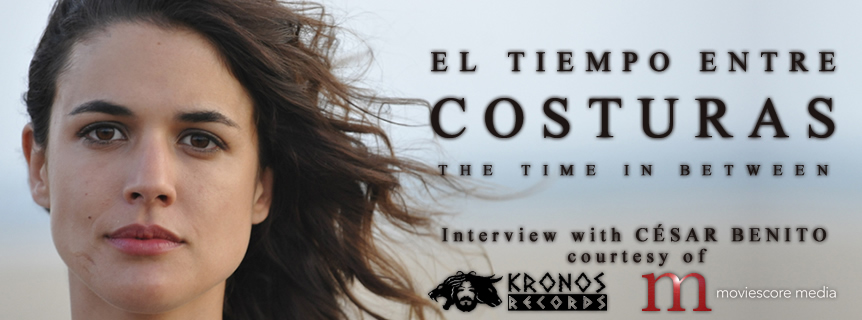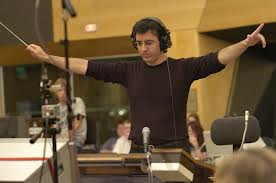Interview with César Benito: The Time in Between

The musical quality in recent years, and this is a very personal opinion (albeit shared with many close friends) is not in the right level of the past years. Films are the greatest exponent, where it has been sacrificed style and skill in benefit of a musical pattern that works more directly, more effective and less passionate in essence. There are examples of the opposite, of course, but they are few cases. And another thing that catches my attention is the music quality in television (this is also a widely shared opinion), it is usually much better than cinema.
Now, the series are excellent vehicles for storytelling and profile characters. Some foreign examples are Dexter, Lost, Battlestar : Galactica, Firefly, Breaking Bad, Boardwalk Empire, … and many times, with excellent compositional work.
At national level, I remember two excellent examples. The first would be Isabel of Federico Jusid a tremendous job, which has nothing to envy to the foreign scores. The second would be El Tiempo Entre Costuras (The Time in Between) of César Benito, a solid and homogenous score, but with many heterogeneous aspects (the characters, the relationships, the plot or the locations ).
 I’ve only seen the pilot episode, but I’ve been listening to the score many times, discovering a musical canvas of high quality, brilliantly executed. The score covers the television product of a great subtlety and raise it to a higher level, or in other words, the serie without Cesar Benito loses dramatic and sentimental effectiveness.
I’ve only seen the pilot episode, but I’ve been listening to the score many times, discovering a musical canvas of high quality, brilliantly executed. The score covers the television product of a great subtlety and raise it to a higher level, or in other words, the serie without Cesar Benito loses dramatic and sentimental effectiveness.
Sira theme is the perfect example, a beautiful melody performed primarily on piano with string accompaniment, a central motif that structures the score and describe the protagonist, a contrast of delicate and innocent with her strength, excellently executed in various tracks like Mi Madre y yo, Dos Extrañas Entre Costuras.
Love, painful but beautiful, starts passionately on the theme dedicated to the relationship between Sira and Ramiro in Tus Pupilas Clavadas en las Mías. This marks the beginning of change in the life of the protagonist, who breaks up with Ignacio, his promised, rushing into the arms of Ramiro, who will gradually shaping up as an opportunistic character and a playboy.
And we have the great ethnic touch for the arrival to Morocco, where the instrumentation gives a touch folk to paint of color the city of Tangier, adding palms and female voice.
 A first chapter that serves perfectly as a guide for sizing and adjusting the work of Cesar Benito as a solid composition, one of the best of the year, and by far.
A first chapter that serves perfectly as a guide for sizing and adjusting the work of Cesar Benito as a solid composition, one of the best of the year, and by far.
Best of all, I still have a world to discover (many chapters to see) and continue enjoying the music of César Benito, who clothes delicately all the vicissitudes of Sira, a detail that empathizes with those who seek quality music to serve a dual purpose: the first, to serve images (the fundamental), and second, enjoy the score out of the images (maybe not so necessary, but when it happens, and this is the case, the fans appreciate it) .
And now, we offer you this interview in exclusive. It was given us by MovieScore Media Records and Kronos Records, to publish in Spanish and English. The score of César Benito can be found in Digital Download on [iTunes/ Amazon] and from AsturScore we thank wholeheartedly this detail by Moviescore Media and Kronos.
1. How did you get on board of the project?
The producers were familiar with my work. I had already scored the TV show La Chica de Ayer (the Spanish remake of the BBC show Life On Mars), and at the time I was scoring another successful TV show Los Protegidos, both produced by the same team that was going to do this project.
I have a very good working relationship with them. Every time I visit Madrid we get together for lunch, and during one of those lunches they told me they had acquired the rights to the novel to produce a TV series, and wanted me to write the score.
2. Could you tell me some details about the schedule for writing the project?
The first thing I did was read the novel–which I loved. The project was postponed a number of times, so I kind of forgot about it and I kept busy with other projects. Every now and then I’d jot down a few ideas with this project in mind.
 By the time I met with the producers again I had a collection of ideas that I recorded and showed to them. They all liked what they heard. We spent that whole afternoon sharing thoughts about the story, the characters, the cast, what different approaches I should take with the music, etc. The enthusiasm of everybody involved with this project was very contagious. We knew that we had something very special.
By the time I met with the producers again I had a collection of ideas that I recorded and showed to them. They all liked what they heard. We spent that whole afternoon sharing thoughts about the story, the characters, the cast, what different approaches I should take with the music, etc. The enthusiasm of everybody involved with this project was very contagious. We knew that we had something very special.
My first scoring task was to set to music a thirteen minute long trailer they put together to show at some film festivals. After that I received the first two episodes to score, simultaneously. Both episodes were very different in tone, and in many other aspects. The first one is set in a happy prewar Spain. The second is much more dramatic, and takes place entirely in Morocco.
Besides scoring on a daily basis, I also had to set up a recording session with a symphonic orchestra to record the main orchestral themes. It was very intense, and stressful at the beginning but once I finished those two episodes things went a bit smoother.
3. What were your instructions / guidelines before you set out to write the score?
They wanted me to write a beautiful score. In their minds they had films like Casablanca, and Lawrence of Arabia…, but they also wanted the score to sound modern, and not like a film score from the Golden Age of Hollywood. They didn’t want the music to sound like an old Spanish cliché either, but rather timeless and elegant with some tasteful Spanish-Mediterranean overtones to it. The rest was left out to my musical intuition.
4. Could you introduce the key thematic ideas (possibly with an illustrative example from the score using the track title)?
This score has a number of themes, some of them only play once in the whole series, some others are recurring, others serve as leitmotifs, etc. Here are some examples:
 Sira’s Theme is the main theme of the series. It accompanies Sira throughout the story. It’s her leitmotif, her musical alter ego. I featured it with different arrangements, styles, and varied instrumentation, but I never changed the key. Always in D minor. That was my subliminal way of showing that Sira was always a person of integrity despite of all the horrible things she had to endure. Everything around her constantly changes–friends of dubious reputation, treacherous lovers, spies, Nazis, danger, and near death experiences, but she remains a kind, strong, good-hearted lady, who always remembers where she came from. We can also listen to this musical idea on A Typewriter, Mother and Me–Two Strangers, Between Stitches, Agent Agoriuq, Seamstress, Spy, Lover, and Woman, and An Open Ending.
Sira’s Theme is the main theme of the series. It accompanies Sira throughout the story. It’s her leitmotif, her musical alter ego. I featured it with different arrangements, styles, and varied instrumentation, but I never changed the key. Always in D minor. That was my subliminal way of showing that Sira was always a person of integrity despite of all the horrible things she had to endure. Everything around her constantly changes–friends of dubious reputation, treacherous lovers, spies, Nazis, danger, and near death experiences, but she remains a kind, strong, good-hearted lady, who always remembers where she came from. We can also listen to this musical idea on A Typewriter, Mother and Me–Two Strangers, Between Stitches, Agent Agoriuq, Seamstress, Spy, Lover, and Woman, and An Open Ending.- Candelaria “La Matutera” is another recurring theme that often accompanies Candelaria, a middle-aged woman from Spain who spent half of her life in Morocco. That’s why it has Spanish as well as Arabic overtones to it.
- His Eyes Fixed On Mine and On The Brink Of The Abyss are long orchestral themes that I used as a whole, or by sections, in many different scenes throughout the whole series, mainly to support romantic and dramatic scenes.
 Trafficking and Smuggling, and Mission: To Escape are sort of kaleidoscope compositions, built with micro-themes I used and combined in different ways throughout the score.
Trafficking and Smuggling, and Mission: To Escape are sort of kaleidoscope compositions, built with micro-themes I used and combined in different ways throughout the score.- In Morocco is very percussive, complemented by claps, and screams, often used in Moroccan folk music, as well as some Arabic-stringed instruments and woodwinds. This piece and its many variations are mainly used to set the right tone when the characters walk through the Souks and the streets of Morocco.
- British Conspiracy and Death Around The Corner are musical compositions that I used to support tension, thriller and chase scenes.
5. Could you discuss some of the North African-flavored music? What kind of research did you do and what special instruments are used?
I started doing research on the Internet, YouTube, Wikipedia, and perused some books on the subject. I love all kinds of ethnic music. Every time I travel I try to buy recordings from the places I visit. I also visit libraries every now and then to see what I can find. I have a wide collection of music from all over the world.
With this project I didn’t have the budget to hire every musician that I needed, so I used instruments from many sample libraries and not always of Moroccan instruments. I even featured a Tam-Tam which is
not very Moroccan at all, but I wanted that sound so I used it! The Moroccan music I have created for this soundtrack is not pure and authentic. It’s more of a personal take on Moroccan and Middle Eastern music.
6. Do you have a favorite scene / cue you’d like to talk about in greater detail?
I have many favorites. I can mention a few off the top of my head:
 There’s a scene where Sira, the protagonist, gets lost on the street at night and has a number of guns hidden under her improvised Arabic gown. I used a short musical theme that I repeat throughout the sequence changing the key and making lots of variations. I think the music really helps the audience understand Sira and suffer the same anguish she is going through.
There’s a scene where Sira, the protagonist, gets lost on the street at night and has a number of guns hidden under her improvised Arabic gown. I used a short musical theme that I repeat throughout the sequence changing the key and making lots of variations. I think the music really helps the audience understand Sira and suffer the same anguish she is going through.
I was very satisfied with the score in the scene where Sira makes a fake Delphos for Rosalinda. The music really enhances the images; it adds excitement and dynamism to a brilliant, wordless sequence.
I think I wrote an inspired melody in The Streets of Lisbon for the scene when Sira arrives in Lisbon by taxi. The music highlights the beautiful monuments and architecture of the city in a scene with no dialogues.
There’s also a thrilling scene when Sira and Markus are getting off the train. The director played with the audience’s emotions making them believe that they are going to cross paths, which is what the viewer wants. But they never do.
They miss each other by inches! I played with these emotions when I wrote the music and built up the excitement with spiccato strings and ascending arpeggios on the piano that go up and up… We can appreciate this music in Tension at the Spanish Protectorate.
7. Was there a really problematic scene / cue that was hard to get right?
The most difficult episode to score was the second one. Initially, I couldn’t get some scenes right. So I worked on those cues until the producers and director were completely satisfied. But I don’t remember a scene that I would call problematic.
8. Please share details about the recording.
We didn’t have a budget that allowed us to record in Los Angeles, which is where I’m based, and there was no time for me to travel to Europe because I was scoring every day. So we decided to record with the Macedonian Radio Symphony Orchestra using a very interesting yet effective “teleconference” method.
 I could watch and listen to the orchestra playing in Macedonia on my computer from my studio in Los Angeles. I was able to communicate with the conductor, and the recording engineer. The orchestra would run the piece and then I would give my notes in English to the conductor. He would speak in Macedonian to the musicians., and then they would play it again. If I wasn’t happy with the performance, I would give him more notes, and they would record the piece until I was satisfied. Then we would move on to the next piece. The session lasted five hours, and it went smoothly.
I could watch and listen to the orchestra playing in Macedonia on my computer from my studio in Los Angeles. I was able to communicate with the conductor, and the recording engineer. The orchestra would run the piece and then I would give my notes in English to the conductor. He would speak in Macedonian to the musicians., and then they would play it again. If I wasn’t happy with the performance, I would give him more notes, and they would record the piece until I was satisfied. Then we would move on to the next piece. The session lasted five hours, and it went smoothly.
A couple of hours after we finished the recording session they sent me the material via an FTP site, and I mixed the music on Pro Tools. I recorded all of the piano parts myself as well as the rest of the score at my studio in Los Angeles.
9. Is there a soloist or performer whose name is to be mentioned?
The only soloist is me at the piano.
10. How was the soundtrack assembled?
 Initially, it didn’t occur to me to publish this soundtrack because I didn’t think that a TV show would draw as much interest as a feature film would. But at some point I changed my mind. I started listening to hours and hours of all the music that I had written for the entire series, and then I selected the most significant pieces. I had to leave out a lot of music that I would have liked to include on this album, but you can only fit so much music on a CD!
Initially, it didn’t occur to me to publish this soundtrack because I didn’t think that a TV show would draw as much interest as a feature film would. But at some point I changed my mind. I started listening to hours and hours of all the music that I had written for the entire series, and then I selected the most significant pieces. I had to leave out a lot of music that I would have liked to include on this album, but you can only fit so much music on a CD!
The music on this album not only represents the most significant moments in the story, it is also ordered in a way that respects the dramatic arc of the story, and the order in which they appear.
My mixing engineer and dear friend Javier Ferreiro, was so kind to find time in his very busy schedule to beautifully remix and remaster all of the tracks to enhance the listening experience on this album.




